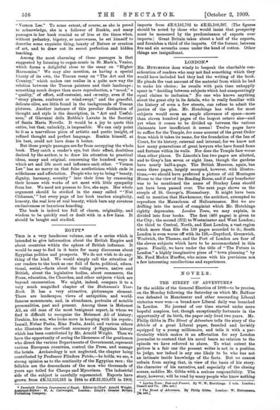LONDON.*
Mn. HUTCHINGS does wisely to bespeak the charitable con- sideration of readers who may not find something which they would have included had they had the writing of the book. He pleads the vast amount of the material from which he had to make his choice ; he recalls with pain time unhappily spent in "deciding between subjects which had exasperatingly equal claims to inclusion." No one who knows anything about the great city in its details, who is really familiar with the history of even a few streets, can refuse to admit the justice of the plea. Mr. Hutchings has what for most subjects would seem an ample allowance of space—more than eleven hundred pages of the largest octavo size—and yet when it comes to be divided up between the various claimants how insufficient it seems ! Twelve pages have to suffice for the Temple, for some account of the great Order from which it takes its name, for the foundation of the Inn of Court, for its history, external and internal, for we know not how many generations of great lawyers who have found fame and fortune within its walls. Nor does the Temple fare worse than other places. To Lincoln's Inn two pages are allotted, and to Gray's Inn seven or eight lines, though the gardens have nearly half-a-page. The British Museum, again, has some three pages, largely occupied, however, with illustra- tions,—we should have preferred a picture of old Montague House to the view of the Reading Room, and if any benefactor was to be mentioned the name of Stuckey Lean should not have been passed over. The next page shows us the steeple of St. George's, Bloomsbury. It might have been well to mention that Hawksmoor, the architect, attempted to reproduce the Mausoleum of Halicarnassus. But we are drifting into the mood of complaint which Mr. Hutchings rightly deprecates. Landon Town, we may explain, is divided into four books. The first (468 pages) is given to the City ; the second (372) to Westminster and West London; the third to Central, North, and East London, a vast region which more than fills the 150 pages accorded to it ; South London is even worse off with its 126,—Deptford, Greenwich, Woolwich, the Thames, and the Port of London are four of the eleven subjects which have to be accommodated in this space. Finally, we have under the title of "The Future in London" a highly imaginative piece of "town planning" by Mr. Ford Madox Hueffer, who mixes with his previsions not a few interesting recollections and experiences.


























































 Previous page
Previous page